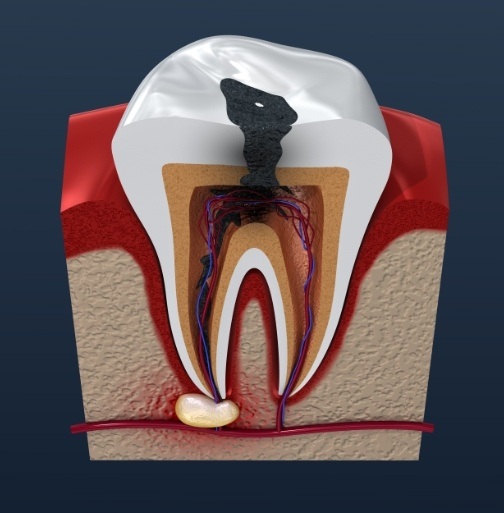Root Canal Therapy – Newington, CT
Removing the
Source of Your Pain
A root canal is a dental treatment procedure that is used to help repair and salvage a tooth that is severely damaged or deeply infected. A root canal can be performed on one or multiple teeth and can help prevent you from needing to have a tooth extraction. The procedure usually takes place within one or more office visits and involves removing a structure within the tooth known as the “pulp” when it has become infected or damaged. Once the infection is removed, the affected tooth can be restored.
Why Choose Cedar Mountain Dental for Root Canal Therapy?
- Multiple Forms of Sedation Available
- Long-Lasting Dazzling Dental Crowns
- Friendly Team with a Gentle Touch
Why do I need a root canal?

Infection or damage of the pulp can occur when a cavity is left untreated or if there is direct injury or trauma to the area. Left untreated, an infected pulp can lead to further infection, which can cause an abscess of the tooth, infection in the root canal, bone loss, and drainage into the gums or cheeks, or swelling of the face, neck, and other surrounding areas.
How do I know if I need a root canal?

Signs and symptoms that a tooth may be infected and that you may need a root canal include tooth sensitivity when chewing or drinking cold/hot food/beverages, gum pain, tooth discoloration (e.g., tooth turning black), swelling in the face or cheek, and dental pain (e.g., painful throbbing sensation in the tooth, sometimes felt in the jaw, ears, or neck).
If you are experiencing any of the mentioned symptoms or other alarming oral concerns, our dental specialists at Cedar Mountain Dental can identify and assess signs of infection and determine if root canal therapy is needed.
When is an emergency root canal needed?

An emergency root canal is needed when the pulp chamber at the center of your tooth and the root canal become damaged or infected. Causes of damage or infection may include:
- Severe and deep dental decay
- Repeated traumatic dental work
- Sustaining injury or trauma to the tooth
- Cracked or chipped tooth
What does an emergency root canal involve?

An emergency root canal can involve anywhere from one to two, or sometimes more, visits to the dentist. The procedure has two goals: remove the infected or damaged pulp from the tooth and restore the tooth, either with a crown or another dental restoration procedure. Overall, a root canal involves four steps:
First, your dentist will perform an oral exam and take necessary X-rays. Once X-rays and the oral exam are complete, your dentist will numb the treatment area with anesthetics. Once the affected tooth is numb, and once you are fully relaxed and comfortable, your dentist will gently fit what is known as a dental dam over the tooth. The dental dam is a small latex sheet that slips over your tooth, almost like a raincoat, protecting the tooth from saliva and bacteria of the mouth.
Once the tooth has been prepared, your dentist will carefully create an opening at the top of your tooth. This opening will allow your dentist to carefully navigate tiny dental instruments into the tooth, remove any infected or damaged pulp from within the tooth, and prepare the inside of the affected tooth for a filling.
After all infected pulp is removed and the tooth has been prepared, your dentist will fill in the root canals, located at the very base of the tooth, with adhesive cement along with another dental material. The adhesive cement helps seal the dental material to the root canals. Your dentist may also use a temporary filling to fill in the empty space directly above the root canals.
For the final step of a root canal, your dentist may fill the tooth with a permanent filling or a crown may be recommended. Both options can help protect and support the tooth, but a crown may offer added benefits, such as added protection against tooth fractures, which teeth are more susceptible to after a root canal. Having a crown implant can also help restore the appearance of the affected tooth.
After root canal surgery, you may experience slight pain. With appropriate aftercare, pain can subside within three days. To help encourage a speedy recovery, you should chew soft foods and brush gently near the treatment area until a crown is in place.
What are the benefits of an emergency root canal?

If your tooth has become severely and deeply infected, a root canal can provide many dental benefits, including:
- Saving affected tooth from a tooth extraction
- Preventing the spread of infection of further complications
- Preserving the health of the affected tooth and surrounding teeth and structures

